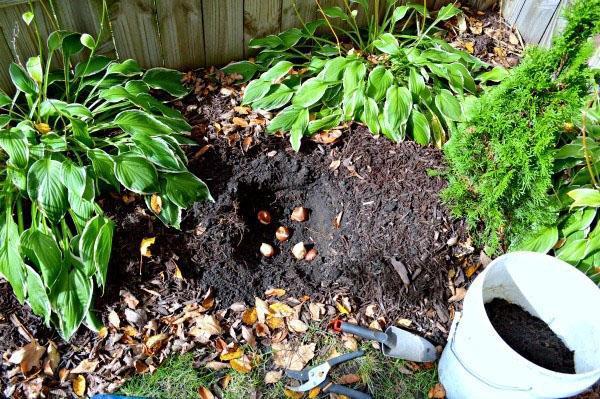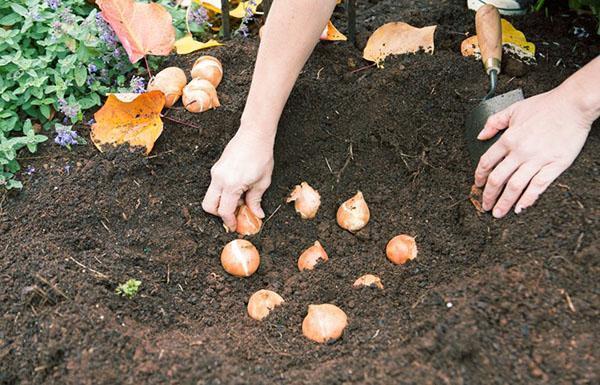We follow the rules of planting and caring for tulips in the open field
 The blooming of tulips heralds the triumph of spring. If the site is decorated with tulips year after year, planting and care in the open field is a key moment of such success. Perennial bulbous plants native to Asia have long been the subject of admiration both in their homeland and in the Old World, where they got in the middle of the 16th century.
The blooming of tulips heralds the triumph of spring. If the site is decorated with tulips year after year, planting and care in the open field is a key moment of such success. Perennial bulbous plants native to Asia have long been the subject of admiration both in their homeland and in the Old World, where they got in the middle of the 16th century.
Thanks to the universal love for these flowers, a hundred years later, Holland began to be called the country of tulips, and today tens of thousands of varieties of these spectacular, but quite affordable plants are distributed around the world.
Watch the video: when to dig up tulip bulbs after flowering?
Dates of planting tulips in the ground

When determining when to plant tulips, it is important not to be mistaken! If the bulbs enter the soil too early, they can produce foliage. And the coming winter will take the plants by surprise. The aboveground part will freeze, the underground part will weaken and cannot guarantee spring bloom. Late planting threatens that tulips will not have time to take root, severe frosts will kill or spoil them.
How to choose the best time? When to plant tulips in the ground in different regions?
Experienced flower growers advise to pay attention not to the calendar, but to the weather outside the window. The best start for plants is to plant in soil that has cooled to 10–12 ° C.
In the middle lane, such conditions develop by mid-September. To the south, tulips are planted later, to the north, the dates are shifted to the end of August.
If for some reason the tulips did not hit the flower beds in the fall, you can plant them in the spring. Unfortunately, in this case, plants have less time to prepare for flowering and accumulate nutrients for the next year. To get the desired result and to simplify the care of tulips in the open field, it is better to germinate the bulbs before planting in peat potsfilled with a loose nutrient substrate. Before planting, the bulbs are cooled for 24 hours in the vegetable compartment of the refrigerator.
 Tulips are transferred to flower beds when it gets warmer and the soil warms up to +15 ° C. This method can be used in all regions, including areas where open field tulips do not survive the winter.
Tulips are transferred to flower beds when it gets warmer and the soil warms up to +15 ° C. This method can be used in all regions, including areas where open field tulips do not survive the winter.
Planting tulips for outdoor cultivation
 For bright flowering garden tulips require:
For bright flowering garden tulips require:
- sun or transparent partial shade;
- nutritious, necessarily loose soil with a neutral or slightly alkaline reaction;
- wind protection;
- moderate watering.
A site suitable for growing tulips is dug up on a full bayonet, loosened, breaking clods, weeds are selected and nitrogen and potash fertilizerssuch as humus and wood ash. Dense, heavy soil is mixed with sand, peat.
Under tulips, as well as under other bulbous crops, you should not add fresh organic matter, which is often a source of bacterial rot and fungal diseases.
The depth of the open field furrows depends on the size of the bulbs. Therefore, they are pre-sorted, simultaneously separating sick and damaged specimens.And healthy ones are immersed in a dense pink solution of potassium permanganate for half an hour and thoroughly dried.
 Under adult large bulbs, furrows are made with a depth of 20 to 30 cm, pouring a 10-centimeter drainage cushion of coarse sand on the bottom. The children are planted, slightly pressing, into holes with the same drainage, but half as small, that is, to a depth of 7-10 cm. When the soil is leveled, the site mulch.
Under adult large bulbs, furrows are made with a depth of 20 to 30 cm, pouring a 10-centimeter drainage cushion of coarse sand on the bottom. The children are planted, slightly pressing, into holes with the same drainage, but half as small, that is, to a depth of 7-10 cm. When the soil is leveled, the site mulch.
Caring for tulips after planting in open ground
 Tulips will respond only to constant and competent care with massive disclosure of bright flowers. Bulbous crops, as a rule, are unpretentious, but still require attention from the appearance of the first leaves until late autumn. Caring for tulips after planting includes:
Tulips will respond only to constant and competent care with massive disclosure of bright flowers. Bulbous crops, as a rule, are unpretentious, but still require attention from the appearance of the first leaves until late autumn. Caring for tulips after planting includes:
- watering, especially plentiful during a set of buds, mass flowering and within 2 weeks after its completion;
- removal of weeds around plantings;
- careful not to damage the root system and bulbs, loosening;
- triple feeding of flowers.
After watering, the soil under the plants should be moist at a depth of 30–40 cm, that is, at least 10–40 liters of water should be consumed per square meter, depending on the type of soil.
Fertilizers in liquid or granular form are part of the post-planting care of your tulips. They are brought in three times:
- During the first sprouting phase, using a mixture of 2 parts nitrogen, 2 parts of phosphorus salts, 1 part of potassium compounds;
- By the time the green buds appear, feeding the plants with nitrogen, phosphorus and potassium in a ratio of 1: 2: 2;
- After flowering, using potassium-phosphorus compounds, completely abandoning nitrogen.
Talking about caring for tulips, one should not forget about a simple but useful procedure. When the flowers wither, they are cut out along with the peduncles. This will prevent the bulbs from wasting energy that is precious for bulb growth.
If boxes with seeds are formed and ripen on the stems, there is no need to wait for large bulbs, and the children will not be able to gain significant mass.
Before growing tulips, you need to know that a culture can stay in one place for no more than 4 years. Then the risk of accumulation of dangerous bacteria, fungi and soil pests increases, the bulbs naturally age and require replanting. The bulbs remaining in the soil gradually go deeper, so the next year it is more difficult for the sprouts to break through to the surface. As a result, the flowers become smaller, the flower stalks become weaker and shorter.
Tulips dig when the leaves completely wither and fall off. It is useful to shed the freed area with a solution of phytosporin, potassium permanganate or any available fungicide. Plants that remain in the soil for the winter, in order to avoid freezing, are densely mulched with peat, sawdust or covered with spruce branches.
How many secrets to grow tulips! These are my favorite flowers! Therefore, this article is very pleased! Special thanks for the video! Very clear and understandable!